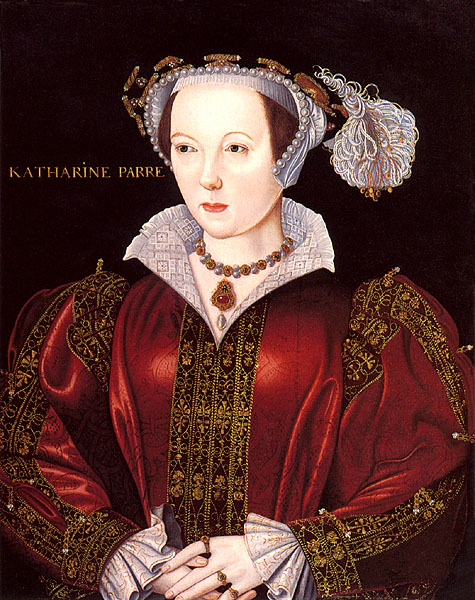
Katherine Parr (Kate) was the eldest daughter of Sir Thomas Parr and his wife Maud Green, both of whom were at the court of Henry VIII in his early reign. Maud was a lady-in-waiting to Queen Catherine of Aragon and named her daughter, born in 1512, after her. So, Henry VIII’s last wife was named after his first. Thomas Parr died in November 1517, leaving his three children, William, Katherine and Anne in the care of their mother. Maud managed the children’s education and the family estates and must have left an impression on her daughter of the greater role an independent woman could have in society. The education that Maud arranged for the children was similar to that of other noble figures of the time and at least in the case of Katherine, it ignited a life-long passion for learning. She was fluent in French, Latin and Italian and began learning Spanish when she was Queen.
Katherine Parr’s first marriage was to Edward Borough, the son of Thomas, third Baron Borough of Gainsborough in 1529 when she was 17 years old. Edward died only a few years later, in early 1533. It was during this marriage that Katherine’s mother Maud died, in December 1531. Katherine’s second marriage was to John Neville, third Baron Latimer of Snape Castle in Yorkshire, whom she married in the summer of 1534 when he was 41 and she was 22. Latimer had two children from his previous marriages so Katherine also became a stepmother for the first time. During the Pilgrimage of Grace a rebel mob forced Latimer to join them and later took Katherine and her stepchildren hostage at the castle. Latimer was able to eventually secure their freedom and managed to escape arrest for his associations with the rebellion after it was finally put down.
Katherine’s ailing husband died in March 1543, leaving her a widow for the second time, now at the age of 31.Katherine was known as "Lady Latimer" It was not long after that Katherine was noticed by not only the King, but also Thomas Seymour, brother of the late Queen Jane Seymour. Katherine expressed her desire to marry Thomas Seymour after Latimer’s death, but the King’s request for her hand was one that Katherine felt it was her duty to accept. Thomas Seymour had never been married and was living as a "Bachelor" at court. Katherine had her reservations toward the rather brash Seymour, but was attracted to what appeared to be the opposite characteristics that she displayed herself. None the less Henry asked for the gentle lady Kate's hand in marriage. The marriage was not only for the kings gain as he had expressed no desire to marry again after the ill fated Kathryn Howard, this was said to be for the Children Elizabeth and Edward whom Katherine took and tended to. Henry was impressed with Katherines closeness with his son and heir Edward.
Katherine and Henry VIII were married on July 12th in the Queen’s closet at Hampton Court Palace in a small ceremony attended by about 20 people.
Katherine was interested in the reformed faith, making her enemies with the conservatives of Henry’s court. The king beleived that she was so pious it was though "his Kate" had married the lord as her bridegroom as oppsed to him.
It was Katherine’s influence with the King and the Henry’s failing health that led to a plot against her in 1546 by the conservative faction. Katherine and her ladies were known to have had banned books which was grounds for arrest and execution on charges of heresy. To gain evidence against the Queen, Anne Askew, a well-known and active Protestant, was questioned and tortured, but refused recant her faith or give evidence against Katherine and her ladies. However, there was enough other evidence against the Queen to issue a warrant for her arrest. The warrant was accidentally dropped and someone loyal to the Queen saw it and then quickly told her about it. This is a well-documented incident that has made its way into many historical fiction accounts.
In this case its as though the history itself is the best drama!
After learning of the arrest warrant, Katherine was said to be very ill, either as a ruse to stall or from a genuine panic attack. Henry went to see her and chastised her for her outspokenness about the reformed religion and his feeling that she was forgetting her place by instructing him on such matters. Katherine’s response in her defense was that she was only arguing with him on these issues so she could be instructed by him, and to take his mind off other troubles. Playing to Henry’s ego helped and Katherine was forgiven. Her faith in God was what Katherine beleived had protected her in her most fearful time.
Katherine was close with all three of her stepchildren as Henry’s wife and was personally involved in the educational program of the younger two, Elizabeth and Edward. She was also a patron of the arts and music. Katherine’s own learning and academic achievements, as alluded to previously, were impressive, and in 1545, her book “Prayers or Meditations” became the first work published by an English Queen under her own name. Another book, “The Lamentation of a Sinner”, was published after Henry VIII’s death.
Katherine was a kind and gentle woman who's only downfall was being true to what she beleived in which was the reformation and the Protestant faith.
There is also a theory that Katherine was a virgin when she married Henry VIII as her previous husbands had been too old and ill to connsumate with her. Whether Henry and Kate had marital relations is a misty subject. This could indeed be why Katherine had not became pregnant until her Marriage of love to Thomas Seymour in 1547.
Henry VIII died in January 1547 and Katherine had expected to play some role in the regency for the new nine-year-old king, Edward VI, but this was not to be. Only a few months after Henry’s death, Katherine secretly married Thomas Seymour, but the quickness and secret nature of the union caused a scandal. Katherine was still able to take guardianship of Princess Elizabeth and Seymour purchased the wardship of the king’s cousin, Lady Jane Grey. It was during this time that the rumors of a relationship between Elizabeth and Seymour arose and Elizabeth was sent to another household in the spring of 1548. Again these were all rumour and hear say.
After three previous marriages and at the age of 37, Katherine was pregnant for the first time and in June 1548, she moved to Sudeley Castle in Gloucestershire to await the birth of her child. On August 30th she gave birth to a daughter named Mary. Katherine soon fell ill with puerperal fever, which was to claim her life in the morning hours of September 5th. Katherine was buried, with Lady Jane Grey as the chief mourner, in the chapel at Sudeley Castle, where the tomb can still be visited today.
Katherine parr, may she be in eternal peace.
Mary was beleived to have died sometime after her Father Thomas Seymours Execution in 1548. Catherine Brandon, formerly Willoughby was Kates best friend and confidant, who is beleived to have taken care of the infant as she had two sons of her own and was to raise a daughter in great joy. Little is known on the exact date of death for Mary Seymour.




No comments:
Post a Comment